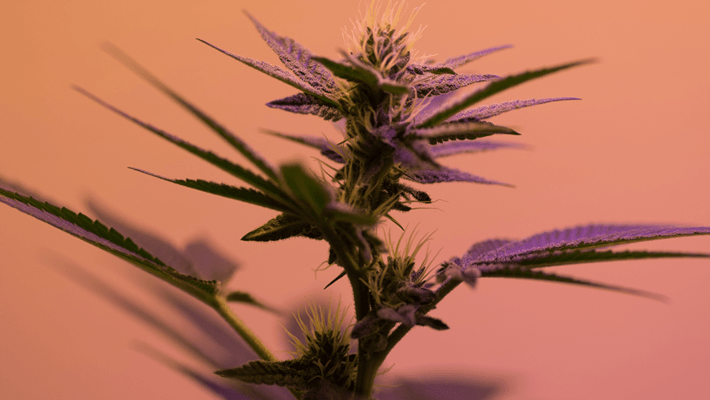
Cannabis Terpenes: What is Linalool?
Published on 3/20/21
You might have observed that not all cannabis strains have the same aroma or taste when smoked. Some smell and taste fruity but others smell earthy and gassy. There are quite a few unique scents when it comes to weed. Non-stoners may find the smell disagreeable and annoying, opposed to cannabis connoisseurs who regularly use cannabis as a perfume or cologne. What is responsible for that distinguishing smell of pot? Cannabis terpenes are the aromatic molecules excreting from within the minuscule resin glands of marijuana flowers and are accountable for producing the individual distinctive tastes and fragrances of different strains. Linalool is one of our favorite terpenes, giving strains like Granddady Purp and Purple Kush that purple color and floral scent we all love.
What is a Terpene?
 Unsplash
UnsplashAside from the smells, terpenes also generate a huge variety of health benefits, as they interact with the bodys olfactory receptors to heighten mood and encourage psychological well-being. The terpenes in weed interact with cannabinoids and intensify the entourage effect. The theory that cannabinoids will work with the body differently depending on which terpenes are present. This is mainly why different strains of marijuana are linked to different therapeutic effects, even when they have the exact same cannabinoid levels, such as THC and CBD. Each terpene has its own terpene profile that includes attributes like the health benefits it offers, vaporization points and what it smells like. Cannabis strains that are especially dank and smelly typically have high levels of terpenes, something you should definitely expect when purchasing top-shelf flower.
If you have ever used essential oils, you have also used terpenes. These fragrant compounds assist a variety of plants to revitalize, oxygenate and oversee their immune systems. Essential oils have been extricated and utilized for many years for an abundant number of purposes, therefore it makes perfect sense that people would value them so much in the cannabis industry. Based on contemporary research, there is no actual difference between marijuana terpenes and the same terpenes in a separate plant. For instance, a spicy terpene by the name of caryophyllene is present in both weed and hops (a plant used in the beer brewing industry), and they are the exact same in both plants. The only difference is that caryophyllene will have contrasting effects depending on whether it is with the compounds found in hops or the cannabinoids found in marijuana. This all points back to the entourage effect, as previously mentioned.
Plants contain terpenes because they help with reconstruction and oxygenation, as well as offer protection from environmental factors. For instance, a particular terpene might be able to entice or repulse distinct animals and insects towards or from the plant. The most riveting thing about these aromatic compounds is the way they can aid a plant with its immune system, and because of this, there is speculation that terpenes can also affect the immunity of human beings as well.
What is Linalool?
 Wikimedia
WikimediaThis specific terpene called linalool has a dainty floral scent, similar to the smell that is associated with lavender, which is largely due to the presence of this fragrant compound in it. Therefore, linalool has become a crucial ingredient in basically all lavender-based beauty products. Despite being a domineering weed terpene, linalool is also present in over 200 other plants, including thyme, clary sage, rosewood, cinnamon, sweet basil, coriander, bergamot, etc. Since it is so common in food, we actually get a considerable amount of linalool through what we ingest on a daily basis, so there is very little risk of unpleasant effects in the quantity we normally would consume the terpene in. In reality, there are a good amount of cases in which one would need to enhance their intake of linalool. However, linalool evaporates pretty fast and is not stored in our fatty tissues, unlike cannabinoids are.
Linalool Effects
With a wide array of benefits and effects, linalool is an extremely restorative terpene. Aside from the ability to reduce stress, linalool has been proven to also act as an antidepressant and antimicrobial as well as help with pain relief. In a rodent-based case study, scientists discovered that linalool assisted mice with managing their depression-like behavior indicators. In some cases, this terpene can also combat infections, which would be incredibly handy in fighting antibiotic-resistant bacteria. When it comes to pain relief, linalool may aid in the management of brain chemicals like glutamate and adenosine, both of which help in regulating the sensation of pain.
This terpene acts like a naturally occurring sedative and is widespread in both traditional and alternative medicines. Coming back to glutamate, linalool can help treat epilepsy by blocking glutamate receptors in the brain since they are accountable for aggravated epileptic episodes, notably decreasing the chance of seizures. Linalool can also play a role in relieving stress by decelerating your heart rate, modulating stress on the immune system and assisting with energy conservation by using the bodys natural parasympathetic reaction. One of the most compelling potential uses for this particular terpene is for the treatment of Alzheimers Disease, a brain degeneration disease that leads to critical memory loss and cognitive impairment. There is currently no cure available for Alzheimers, but linalool is being looked into as a possible treatment. A 2016 case study done on mice showed that linalool was able to reverse a remarkable amount of cognitive and behavioral deteriorations associated with this disease. However, this kind of testing still needs to be done on human beings.
High Linalool Strains
Linalool is extremely prevalent in marijuana. If your bud smells like lavender, then theres a good chance it has a high linalool content. Some of the more well-known strains containing linalool are:
What are your favorite cannabis terpenes? Share with us in the comments below!
